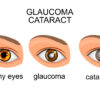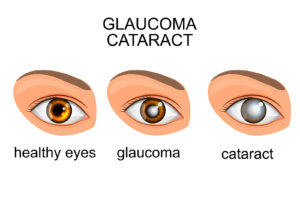
Common Eye Disorder Glossary
Here at Rebuild Your Vision, we believe that you can improve your vision and protect your eye health through natural methods. It’s amazing how getting a nutrient-rich diet, staying active, and getting regular checkups can impact your sight. Many people take the shortcut to clear vision by getting glasses, contact lenses, or even surgery. While these are effective in the short term, they don’t help to treat the underlying issues. Here are the most common eye disorder descriptions and how they impact your sight.
Do You Suffer from This Eye Disorder?
Macular Degeneration: This condition is also known as “Age-Related Macular Degeneration” because it commonly occurs later in life. When the macula area of the retina begins to break down, you can lose your vision. You may also notice a decline in your ability to see fine details and identify different colors. At the first sign of AMD, you should consult your doctor. They will provide an eye exam and suggest treatment methods.
Astigmatism: This is a condition that affects the curvature of the cornea. For the cornea to direct light into the retina, it needs to be perfectly curved to the surface of your eye. Astigmatism causes an abnormal curvature that impacts your vision. This can cause two focal points making objects up close and at a distance blurry. Eye exercises are a form of treatment and prevention you can do anywhere. Remember, the natural route isn’t always the fastest. Although getting prescriptive lenses will improve your vision right now, they won’t treat astigmatism.
Cataracts: Cataracts affect millions of people around the world. While they occur most often in elderly patients, babies can also have this condition. The symptoms include a clouding of the lens which inhibits the eye’s ability to transmit light and see effectively. To prevent cataracts, ensure you’re getting enough of the right eye-boosting nutrients. If you can’t get them through your diet, take a natural supplement.
Conjunctivitis: More commonly known as pink eye, conjunctivitis is an inflammation of the blood vessels in the eyelids. Conjunctivitis is caused by bacteria or viruses, and it is very contagious. When we think of pink eye, we tend to expect the patients to be young children. Bacteria and viruses can spread rapidly through schools and daycare centers. Ensure your children understand the importance of hand-washing and how to do it properly.
Retinopathy: Also known as “diabetic retinopathy,” retinopathy is a common eye disorder of the retina in people who suffer from diabetes. It is a result of too much sugar in the blood. Over time, this causes the tiny but instrumental blood vessels around the eyes to close. New blood vessels may grow, but they’re often leaky and ineffective. People with type 1 or 2 diabetes can suffer from retinopathy and eventually lose their vision. You can prevent retinopathy in some cases by treating your diabetes from the onset.
Dry Eye Syndrome: This is a very common eye condition that occurs when there is not enough moisture in the eye. It can make the eyes feel dry, sandy, and gritty. Dry eye can occur due to a number of factors including low humidity, smoking, aging, and certain medications. It could also be a sign of an underlying health condition so it’s best to see a doctor for an exam.

Glaucoma: Glaucoma is a serious disease of the eye that causes fluid and pressure to build up and damage the optic nerve. It’s a genetic disease that tends to show up later in life. However, poor lifestyle habits such as smoking, drinking excessively and not eating a clean diet can play a role in the onset of glaucoma. You can prevent glaucoma by making healthy life choices.
Presbyopia: This is the medical term for farsightedness, a condition that makes it difficult to see clearly up close. Patients will often use reading glasses to read their text messages, menus, and other up-close text. You can improve your hyperopia by doing eye exercises specifically for this condition.
Myopia: This is the medical term for nearsightedness, a condition that makes seeing objects at a distance hard. This is dangerous when driving a car or operating heavy machinery. Patients will normally opt for prescriptive lenses, but there are eye exercises for myopia that can prevent and decrease it.
Retinal Detachment: This is a serious condition that occurs from injury, previous eye surgery, inflammation, and even genetics. It’s the separation of the retina from the back of the eye. If left untreated, it can lead to blindness in the affected eye. It’s important to go to the hospital immediately if you suffer trauma and lose some or all of your vision.
Strabismus: When the eyes are unable to move from a crossed position, it’s called strabismus. Children can be born with this condition and require physical therapy or surgery to fix it. Although it doesn’t cause physical pain, it can be a source of insecurity for the child. Early detection and treatment are usually very effective at correcting this condition.
Stye: A stye is a non-contiguous, bacterial infection of the glands of the eyelid. It usually shows up as a small, red bump either on the eyelid or on the edge of the eyelid. It can appear to be a pimple but should not be popped. The best remedy is to repeatedly apply a warm compress to the eye area until it disappears. Also, be wary of sharing eye makeup with others, as this can spread bacteria. You may also get a stye if bacteria from the nose transmits through touch to the eye.
What You Can Do
The eyes are very sensitive organs that are vulnerable to a wide array of conditions. This list is a comprehensive glossary of the most common eye disorders. Although prescriptive lenses and surgery are often recommended, know that there are also natural treatments for some conditions. You can improve your eyesight and eye health by maintaining a healthy diet and exercising your eyes daily. See your eye doctor for a checkup regularly and report any unusual symptoms to them. Early detection and treatment are the best ways to prevent a condition from progressing.
Our Rebuild Your Vision Ocu-Plus Formula Contains All 17 Vitamins, Minerals, and Herbal Supplements to Improve Your Eye Health!












am looking for specific information and exercises to keep the inter ocular pressure at a normal level, whatever that is. the internet has varied responses.my pressure is 19 left eye and 16 right eye, the optic nerve and poeriferal vision are fine.and healthy.the eye test was done at sea level and in a hot climate.normally i live up a mountain and cooler.i am 66 years old.
also specific eye exercises for the lenses which are just starting to harden a little apparently. i eat a very clean diet, macrobiotics, do not smoke drink or take drugs.
many thanks valerie